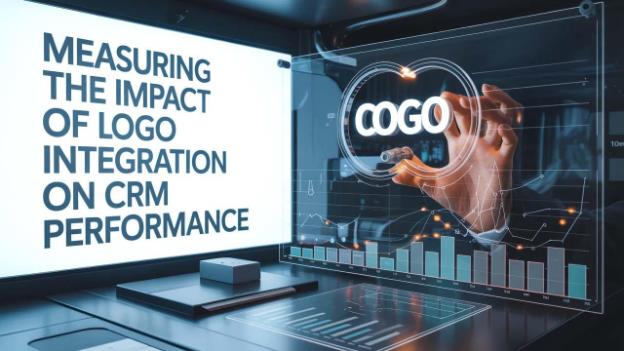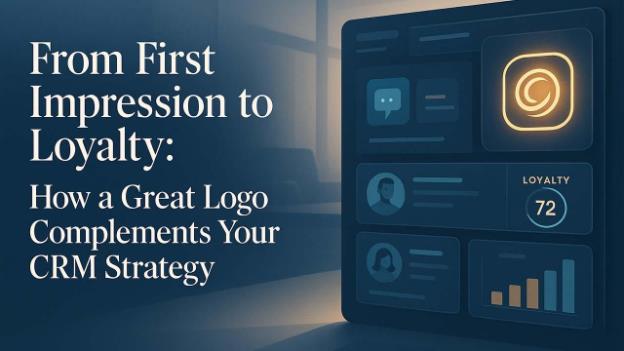Most business owners treat their logo and customer relationship management (CRM) as separate investments. They'll spend thousands on a great logo design and then forget about it when setting up their CRM system, and vice versa.
This disconnect costs businesses money. Companies lose trust, engagement, and sales opportunities when customers can't instantly recognize a brand across every touchpoint.
However, when a logo works alongside the CRM strategy, emails get recognized, customer interactions seem professional, and the brand identity gets established at each touchpoint.
This guide explores logo integration into a CRM system and its many benefits. You can boost brand recognition, increase email open rates, and build long-term customer relationships with higher retention rates.
Your CRM's Secret Weapon: The Logo
Your logo is more than just an attractive picture on the business card; it's a strategic asset. It can significantly improve your CRM performance.
Logo Recognition and the Psychology that Supports It
The repeated visibility of your logo among your customers triggers a psychological effect called the "mere exposure effect." People prefer things that they've seen before, even if there is no conscious recollection.
Logos access the part of our brains that processes the information naturally. Images are remembered much faster by our minds compared to text. Thus, a person’s memory can hold a simple logo even after one glance.
A familiar logo is an indication that others use this brand too, creating social proof. It consumes less mental energy to recognize something familiar; understanding something new can be more tedious.
Logos leverage natural brain patterns to establish instant brand recognition. They could be created by a professional designer or with a logo maker.
Impact of Logo Recognition on Your CRM Metrics
Major CRM metrics report significant improvement when the logo gets recognized by the customers instantly across all touchpoints. You can achieve higher email open rates, increased customer lifetime value, and better support query resolution.
During support communications when customers see your logo, they feel more confident. They understand that they are dealing with the official brand, making the interactions smoother.
5 Ways to Integrate Your Logo into Your CRM Strategy
Maintaining consistency across every customer pathway is crucial for successful integration. Below are the five proven methods using which you can incorporate your brand’s identity throughout your CRM system. This provides a seamless experience for building trust and recognition.
1. Brand recognition through email marketing template optimization
You get direct access to your customers' inboxes through email marketing that makes it a prime location for logo placement. However, people receive hundreds of emails every day. So, it is essential to ensure that your logo is eye catching and builds instant recognition.
You can use the following ways to maximize the logo’s impact:
- Header placement: Your logo must be on the top-left corner of every email template. This is in accordance with natural reading patterns and provides immediate recognition.
- Size optimization: The size of your logo must be large enough for it to get recognized on mobile devices. It should not dominate the message. To ensure correct display, you can test your logo on different screen sizes.
- Welcome email series: The engagement rates of welcome logos are higher than other types of email. This opportunity is ideal for the prominent display of your logo. Now, it is the first thing new subscribers see.
- Automated drip campaigns: Include your logo in every email sequence. Since customers might receive these emails weeks or months apart, consistent logo presence maintains brand continuity.
2. Create branded customer onboarding experiences
For long-term retention, the first few months after a customer signs up, play an important role. In this journey, your logo should act like a guide for providing a sense of familiarity and trust.
A well-structured and branded customer onboarding experience with personalized feel needs the right CRM tool. They lead the personalization and timing of the early interactions. In fact, the strategic moment for CRM to make an impact is onboarding. According to ScienceSoft, the discovery phase which is the first phase of the CRM implementation plan involves a detailed analysis of your team’s workflows, points of friction, and inefficiencies. This process gives insight into the new users’ needs. You can design user-centric onboarding journeys that are intuitive and relevant.
For instance, if it is tracked by your CRM when a new customer opens the welcome email, you can set up a trigger to automatically send a follow-up message in case they do not activate their account. This message would contain helpful information and a link to redirect them to a branded dashboard with your logo. You can reinforce the trust subtly and provide a gentle push towards the onboarding cycle, mitigating the risk of them dropping off.
With the early involvement of leadership and frontline employees, businesses can craft onboarding journeys that address real-world hurdles and enhance customer satisfaction.
You can boost engagement through your:
- Welcome portal design: Customer dashboard login screens and welcome pages should display your logo prominently. You can create a branded environment that feels professional and secure.
- Onboarding email sequences: Your logo must be consistent across all onboarding communications. The early relationship phase is critical. Your logo reinforces your brand identity while offering a cohesive experience.
- Progress indicators: The onboarding checklists and progress bars should be branded with your logo. Customers get a sense of progress within your ecosystem, with this subtle branding.
- Support documentation: Help articles, FAQs, and tutorial videos must integrate your logo to reassure customers that they are accessing official resources.
3. Branded touchpoints to enhance customer support
You get an opportunity to reinforce your brand identity with each customer interaction. This way customers associate brand positivity with problem-solving and customer care. For instance:
- Support ticket headers: Automated support ticket confirmations and responses should have your logo. This immediately identifies the communication as official and creates a professional impression even when customers are experiencing problems.
- Live chat widgets: Brand your chat interface with your logo to create trust and professionalism. If customers realize that they're communicating with your official support team, they get encouraged to share sensitive information.
- Knowledge-based design: All self-service resources should have your logo. This enables unified help experience and lets the customers know that they are accessing official, up-to-date information.
- Video support content: Video tutorials or support content that you create should incorporate your logo. This reinforces your brand authority while preventing others from using your content without acknowledgement.
4. Personalize customer communication at scale
You can maintain brand consistency while personalizing at scale using modern CRM systems. For effective logo integration across tailored touchpoints, you can do the following:
- Dynamic email signatures: During customer communications, use automation to add your logo to all email signatures. This ensures that your brand identity is reinforced through each interaction, irrespective of the team member driving it.
- Proposal templates: Maintain professional consistency in all sales proposals and quotations with your brand logo. This creates a cohesive experience throughout the sales cycle.
- Customer reports: Any reports or analytics that you share with the customers must have your logo. This highlights your niche-expertise while adding credibility to your data.
- Milestone celebration emails: Maintain brand presence during positive moments with birthday, anniversary, and achievement emails that have your logo. This way, customers associate positivity with your brand during an emotionally meaningful period.
5. Benefit from social proof and user-generated content
Use methods that showcase your logo and create organic social proof by encouraging customers to engage with your brand. This includes:
- Customer collaboration campaigns: Provide branded templates so that customers can easily share positive experiences with your logo. This authentic customer advocacy can expand your brand reach while maintaining visual consistency.
- Social media integration: Social media mentions can be tracked and responded to using CRM, maintaining a consistent logo presence. You can build a cohesive brand ecosystem across all platforms and channels.
- Case study publication: Customer success stories and case studies should have your logo distinctly. You can showcase your brand’s real-life achievements to establish credibility and authority.
- Referral program materials: All referral communications must have your logo. As customers share with their networks, you can maintain brand consistency.
Measuring the Impact of Great Logo Integration on CRM Performance

There are specific metrics that showcase the performance of your logo integration. These measurements show stakeholders the business value of your branding efforts and help optimize your strategy.
Email marketing metrics
Your email performance gives you the fastest and most precise results from logo integration. Set up your baseline metrics before you start, then track changes over 90 days.
- Open rates often elevate after the addition of logos to the emails. This can be observed within the first month. This is due to the recognition and trust that people develop for your logo amidst the cluttered inbox.
- Click-through rates often show higher increments than open rates as well. Look for 10-15% increases when your logo appears in email headers and throughout your content.
- Efficient logo branding reduces unsubscribing rates by 3-7%. People feel more confident about legitimate and professional communications with good branding.
Customer engagement metrics
These metrics are an indication of the effects of logo integration on customer experience. You can track them quarterly as meaningful changes take longer to be visible.
- Onboarding duration often increases when there is a consistent use of the logo throughout the customer journey. People find branded content more official and trustworthy, making them want to spend longer.
- Support ticket gets resolved faster with branded communications. When customers see the logo, they know that they are dealing with the official support team. This encourages them to cooperate better and solve problems faster.
- Customer satisfaction scores steadily increase by 0.5-1.0 points on a 5-point scale with strategic logo branding.
Revenue impact metrics
These metrics show the ultimate business value of logo integration. Since they take time to develop, track them quarterly and annually.
- Customer lifetime value often increases for customers who experience consistent logo branding compared to those who don't. Stronger brand recognition leads to more trust, repeat purchases, and less price sensitivity.
- Repeat purchase rates are higher after email campaigns with logo integrations compared to non-branded ones.
- Referral rates mark a rise from customers who experience branded communications. A more memorable and professional impression can be created with consistent branding. As a result, customers feel confident recommending the brand to others.
Common Logo Integration Mistakes That Hurt CRM Performance
The following mistakes can have a negative impact on your CRM effectiveness:
Logo overuse
Customers can feel overwhelmed due to the overuse of the logo or its extremely large size. This can reduce the message effectiveness. Businesses often think that more is better. However, logo overcrowding can lead to visual clutter, which can be distracting for the customers who won’t be able to focus on the main message.
Constant branding can annoy customers who may start ignoring your emails. Your logo should be prominent and placed in your content with a balanced approach. It should be integrated strategically at key touchpoints instead of being displayed everywhere.
Inconsistent versions
Customers get confused if there are variations in logo across CRM touchpoints, thus weakening the brand recognition. This occurs due to the use of outdated logo files or in cases when the brand guidelines have not been established clearly.
To build recognition, customers need to see the same logo consistently. You can store all the approved logo versions in an asset library and ensure that the same file is used by all the team members. Mention the size, color, and placement specifications to maintain consistency.
Poor mobile optimization
Logos that don't display correctly on mobile devices create negative user experiences. Since most emails are opened on mobile devices, a logo that's too large, pixelated, or doesn't load properly can damage your brand image.
It is recommended to check your logo across different screen sizes and email clients. Ensure that the logo loads quickly, without distortion on smartphones and tablets. If needed, you can also design logo versions that are mobile-first.
Neglecting accessibility
Some customers can get excluded from your communications if you use logos without proper alt text or color contrast. This is more than about compliance; it ensures that there is effective engagement with all your customers.
All logo images should be integrated with descriptive alt text to enable screen readers to describe them to users with visual impairment. There should be sufficient color contrast in your logo against background. Also provide text alternatives when necessary.
Generic placement
Random logo placement without customer flow and attention pattern considerations can reduce its impact. Your logo should not be displayed wherever there is space. Instead choose areas where customers look naturally.
Analyse people’s behavior when reading emails and web pages. Using this, you can place your logo strategically. Generally, the top-left corner receives maximum attention. This is followed by the header area. It is advisable not to place logos in areas where they must compete with calls-to-action.
Ready to Get Started?
Your logo is more than a visual identity. Thoughtful integration of your logo acts as a strategic tool that can significantly improve your CRM performance.
You can start with small implementations, such as email marketing optimization, and gradually expand across all CRM touchpoints. Monitor the results to understand the meaningful impact that this simple change can have on your customer relationships and business growth.
Consistent and memorable experiences at every customer touchpoint is the way for businesses to succeed in the current competitive market. Your logo is the thread that ties it all together.



